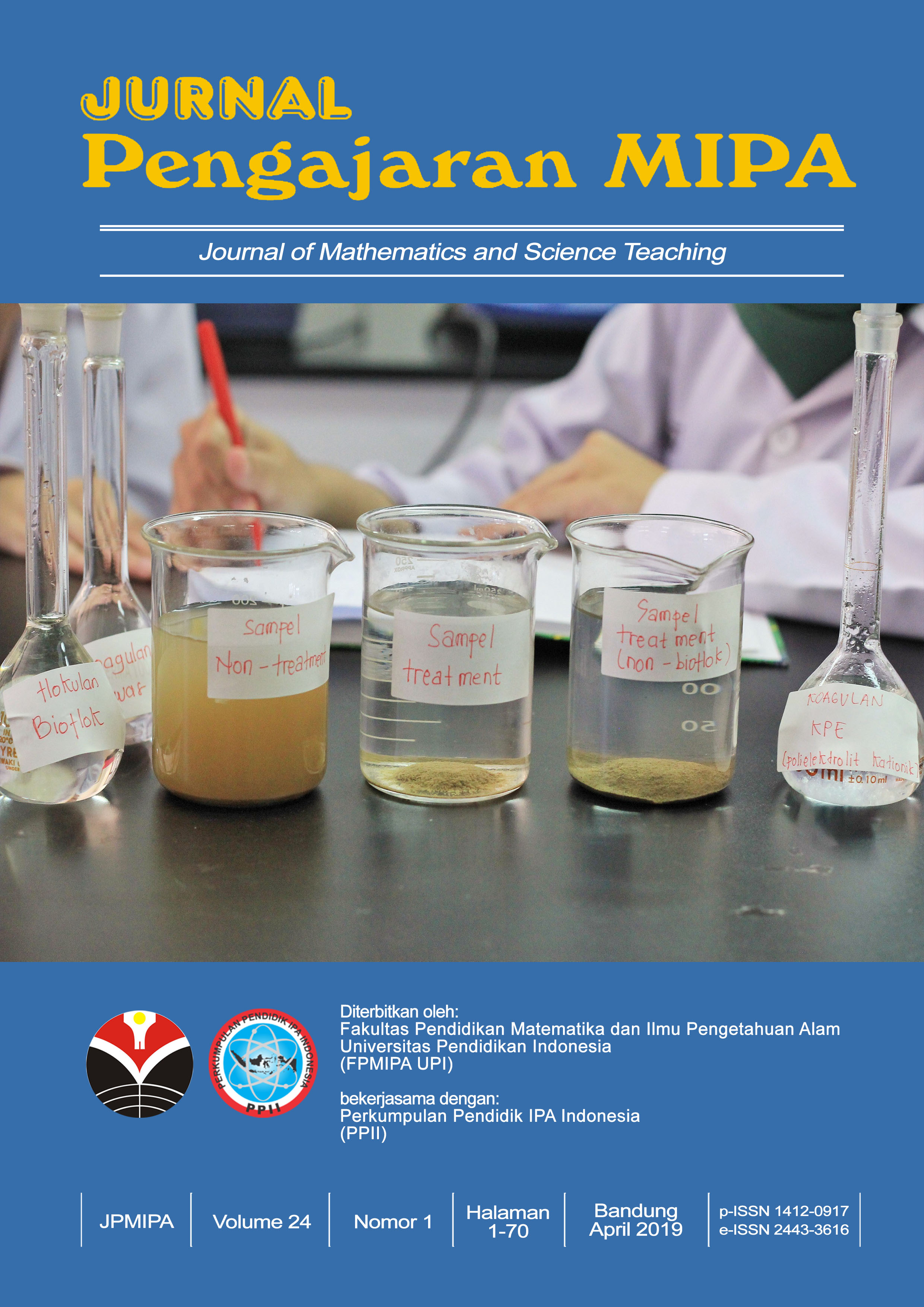THE ANALYSIS OF JUNIOR HIGH SCHOOL STUDENTS’ COMMUNICATION AND COLLABORATION SKILLS IMPROVEMENT USING MULTIMEDIA-BASED INTEGRATED INSTRUCTION (MBI2) IN LEARNING REFLECTION CONCEPT
Abstract
This study identifies communication and collaboration skills improvement of junior high school (SMP) students when learning physics using Integrated Multimedia-based Instruction (MBI2). In this one-shot case study, the subject was thirty-one eight grade students in one of the public schools in Bandung, West Java. Students’ communication and collaboration skills were evaluated by learning and laboratory activity observation. Results showed that communication and collaboration skills were improved with four meetings that suggested that MBI2 could improve junior high school students’ communication and collaboration skills.
Abstrak
Penelitian ini mengidentifikasi perbaikan keterampilan komunikasi dan kolaborasi siswa Sekolah Menengah Pertama (SMP) ketika belajar Fisika dengan menggunakan Integrated Multimedia-based Instruction (MBI2). Dalam one-shot case study ini, subjek adalah 31 siswa di salah satu sekolah negeri di Bandung, Jawa Barat. Keterampilan komunikasi dan kolaborasi siswa dievaluasi melalui observasi kegiatan pembelajaran dan praktikum. Hasil menunjukkan abhwa keterampilan komunikasi dan kolaborasi membaik dalam empat pertemuan yang mengimplikasikan bahwa MBI2 dapat memperbaiki keterampilan komunikasi dan kolaborasi siswa SMP.
Keywords
Full Text:
PDFReferences
Arifin, Z. (2014). Evaluasi Pembelajaran. Bandung: PT. Remaja Rosdakarya.
Association of American Colleges and Universities. (2014). Written Communication Rubric. Utah: Association of American Colleges and Universities.
Binkley, M., Erstad, O., Herman, J., Raizen, S., Ripley, M., Miller-Ricci, M., & Rumble, M. (2012). Defining twenty-first century skills. In: Griffin P., McGaw B., Care E. (Eds.) Assessment and Teaching of 21st Century Skills. Dordrecht: Springer.
Bayraktar, S. (2001). A Meta-analysis of the Effectiveness of Computer-Assisted Instruct-ion in Science Education. Journal of Research on Technology in Education, 34(2), 173–188.
search on Technology in Education, 34(2), 173–188.
Chang, H-P., Chen, J-Y., Guo, C-J., Chen, C-C., Chang, C-Y., Lin, S-H., Su, W-J., Lain, K-D., Hsu, S-Y., Lin, J-L., Chen, C-C., Cheng, Y-T., Wang, L-S., & Tseng, Y-T. (2007). Investigating Primary and Secondary Students’ Learning of Physics Concepts in Taiwan. International Journal of Science Education, 29(4), 465-482.
Chen, Z., Stelzer, T., & Gladding, G. (2010). Using Multimedia Modules to better prepare students for introductory Physics Lecture. Physical Review Special Topics-Physics Edu-cation Research, 6, 010108.
Coll, R.C., & Zegwaard, K.E. (2006). Perceptions of desirable graduate competencies for sci-ence and technology new graduates. Re-search in Science & Technological Edu-cation, 24(1), 29-58.
Deiglmayr, A., & Spada, H. (2010). Developing Adaptive Collaboration Support: The Exam-ple of an Effective Training for Collaborative Inferences. Educational Psychology Review, 22, 103–113.
Fletcher-Flinn, C. M., & Gravatt, B. (1995). The Efficacy of Computer Assisted Instruction (CAI): A Meta-Analysis. Journal of Educa-tional Computing Research, 12(3), 219–241.
Gray, E., Emerson, L., MacKay, B. (2005). Meet-ing the Demands of the Workplace: Science Students and Written Skills. Journal of Sci-ence Education and Technology, 14(4), 425-435.
Griffin P., Care E., McGaw B. (2012). The Chang-ing Role of Education and Schools. In: Grif-fin P., McGaw B., Care E. (Eds.) Assessment and Teaching of 21st Century Skills. Dor-drecht: Springer.
Hermawan, H., Siahaan, P., Suhendi, E., & Samsudin, A. (2017). Promoting Collabo-ration Skills on Reflection Concept through Multimedia-Based Integrated Instruction. AIP Conference Proceedings, 1848, 050009.
International Reading Association. (2005). Read Write Think “Collaborative Work Skills Rub-ric”. Washington D.C.: International Read-ing Association
Kirstein, J., & Nordmeier, V. (2007). Multimedia representation of experiments in physics. Eu-ropean Journal of Physics, 28(3), S115–S126.
Mullis, I. V. S., Martin, M. O., Foy, P., & Hooper, M. (2016). TIMSS Advanced 2015 Inter-national Results in Advanced Mathematics and Physics. Massachusetts: TIMSS & PIRLS International Study Center.
Sarkar, M., Overton, T., Thompson, C., & Rayner, G. (2016). Employability: Views of Recent Science Graduates and Employers. Interna-tional Journal of Innovation in Science and Mathematics Education, 24(3), 31-48.
Schroeder, N.L., & Cencki, A.T. (2018). Spatial Contiguity and Spatial Split-Attention Effects in Multimedia Learning Environ-ments: A Meta-Analysis. Educational Psy-chology Review, 30(3), 679-701.
Sharma, M., Pollard, J., Mendez, A., Mills, D., O’Byrne, J., Scott, D., Hagon, S., Gribble, J., Kirkup, L., Low, D., Merchant, A., Rayner, A., Swan, G., Zadnik, M., & Zealey, W. (2007). What does a physics undergraduate education give you? A perspective from Australian physics. European Journal of Physics, 29(1), 59–72.
Siahaan, P., Suryani, A., Kaniawati, Suhendi, E., & Samsudin, A. (2017). Improving Students’ Science Process Skills through Simple Com-puter Simulations on Linear Motion Con-ceptions. IOP Conf. Series: Journal of Phy-sics: Conf. Series, 812,012017.
Sperandeo-Mineo, R.M., Fazio, C., & Tarantino, G. (2006). Pedagogical Content Knowledge Development and Pre-Service Physics Edu-cation: A Case Study. Research in Science Education, 36, 235-268.
Spektor-Levy, O., Eylon, B., & Scherz, Z. (2009). Teaching Scientific Communication Skills in Science Studies: Does It Make A Difference? International Journal of Science and Mathematics Education, 7, 875-903.
Stanton-Chapman, T. L., Denning, C. B., & Jamison, K. R. (2010). Communication Skill Building in Young Children with and without Disabilities in a Preschool Classroom. The Journal of Special Education, 46(2), 78–93.
Torenbeek, M., Jansen, E. P. W. A., & Hofman, W. H. A. (2011). Predicting first-year achievement by pedagogy and skill development in the first weeks at university. Teaching in Higher Education, 16(6), 655–668.
Tural, G. (2015). Cross-Grade Comparison of Students’ Conceptual Understanding with Lenses in Geometric Optics. Science Education International, 26(3), 325-343.
Yeo, S., Loss, R., Zadnik, M., Harrison, A., & Treagust, D. (2004). What do students really learn from interactive multimedia? A physics case study. American Journal of Physics, 72, 1351-1358.
Zane, T. W. (2011). How to Create Your Written Communications Scoring Rubrics A Step-by-Step Approach. Salt Lake County: Salt Lake Community College.
DOI: https://doi.org/10.18269/jpmipa.v23i2.13981
Refbacks
- There are currently no refbacks.
Copyright (c) 2019 Jurnal Pengajaran MIPA

This work is licensed under a Creative Commons Attribution-ShareAlike 4.0 International License.
JPMIPA http://ejournal.upi.edu/index.php/jpmipa/index is licensed under a Creative Commons Attribution-ShareAlike 4.0 International License
Jurnal Pengajaran Matematika dan Ilmu Pengetahuan Alam (JPMIPA) or Journal of Mathematics and Science Teaching
All rights reserverd. pISSN 1412-0917 eISSN 2443-3616
Copyright © Faculty of Mathematics and Science Education (FPMIPA) Universitas Pendidikan Indonesia (UPI)
View JPMIPA Stats









